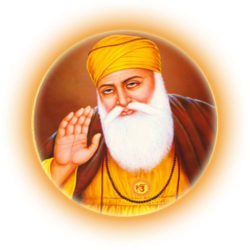SIKHISM
Origin of Sikhism
Sikhism was founded on the teachings of Guru Nanak and nine successive Sikh Gurus in fifteenth century Punjab. It is the fifth-largest organized religion in the world. This system of religious philosophy and expression has been traditionally known as the Gurmat (literally the counsel of the gurus) or the Sikh Dharma. Sikhism originated from the word Sikh, which in turn comes from the Sanskrit root śiṣya meaning "disciple" or "learner", or śikṣa meaning "instruction."
The principal belief of Sikhism is faith in Vāhigurū—represented using the sacred symbol of ēk ōaṅkār, the Universal God. Sikhism advocates the pursuit of salvation through disciplined, personal meditation on the name and message of God. A key distinctive feature of Sikhism is a non-anthropomorphic concept of God, to the extent that one can interpret God as the Universe itself. The followers of Sikhism are ordained to follow the teachings of the ten Sikh gurus, or enlightened leaders, as well as the holy scripture entitled the Gurū Granth Sāhib, which, along with the writings of six of the ten Sikh Gurus, includes selected works of many devotees from diverse socio-economic and religious backgrounds. The text was decreed by Gobind Singh, the tenth guru, as the final guru of the Khalsa Panth. Sikhism's traditions and teachings are distinctively associated with the history, society and culture of the Punjab. Adherents of Sikhism are known as Sikhs (students or disciples) and number over 23 million across the world. Most Sikhs live in Punjab in India and prior to the Indias partition, millions of Sikhs lived in what is now Pakistani Punjab.
History
Sikhism, the youngest of the world religions, is barely five hundred years old. Its founder, Guru Nanak, was born in 1469. Guru Nanak spread a simple message of "Ek Ong Kar": we are all one, created by the One Creator of all Creation. This was at a time when India was being torn apart by castes, sectarianism, religious factions, and fanaticism. He aligned with no religion, and respected all religions. He expressed the reality that there is one God and many paths, and the Name of God is Truth, "Sat Nam".
Guru Nanak's Hindu and Muslim followers began to be called Sikhs (learners). He taught them to bow only before God, and to link themselves to the Guru, the Light of Truth, who lives always in direct consciousness of God, experiencing no separation.
Sikh Festivals
Literally festivals, Gurupurabs are anniversaries associated with the lives of the Sikh Gurus. The Sikhs celebrate 10 Gurpurabs in a year. On each of these festivals, one of the ten gurus of the Khalsa Pantha is honored. Of these, the important ones are the birthdays of Guru Nanak and Guru Govind Singh and the martyrdom days of Guru Arjun Dev and Guru Teg Bahadur.
Baisakhi is New Years Day in Punjab. It falls on the month of Vaisakh. This festival marks the ripening of the Rabi harvest. The day coincides with the solar equinox on the13th of April. It was on this day that the tenth Sikh Guru, Guru Gobind Singh, founded the Khalsa (the Sikh brotherhood) in 1699. For Sikhs, this is as a collective birthday. It is celebrated on April 13, though once in 36 years it occurs on 14th April. The tenth guru Guru Govind Singh selected the auspicious day of Baisakhi to form the order of the Khalsa.
Holla Mohalla is a Sikh festival celebrated in the month of Phalguna , a day after Holi. An annual festival held at Anandpur Sahib in Punjab, Hola Mohalla was started by the tenth Sikh Guru, Gobind Singh, as a gathering of Sikhs for military exercises and mock battles on the day following the festival of Holi. It reminds the people of valour and defence preparedness, concepts dear to the Tenth Guru who was at that time battling the Mughal empire. On this three-day festival mock battles are held followed by music and poetry competitions. The Nihang Singhs (members of the Sikh army that was founded by Guru Govind Singh) carry on the martial tradition with mock battles and displays of swordsmanship and horse riding. They perform daring feats, such as Gatka (mock encounters), tent pegging, bareback horse-riding and standing erect on two speeding horses.
Maghi is the occassion when Sikhs commemorate the sacrifice of 40 Sikhs, who fought for Guru Gobind Singh Ji. Maghi, Makara Sankranti, the first day of the month of Magh. The eve of Maghi is the common Indian festival of Lohri when bonfires are lit in Hindu homes to greet the birth of sons in the families and alms are distributed. In the morning, people go out for an early-hour dip in nearby tanks. For Sikhs, Maghi means primarily the festival at Muktsar, a district town of the Punjab, in commemoration of the heroic fight of the Chali Mukte, literally, the Forty Liberated Ones, who laid down their lives warding off an attack by an imperial army marching in pursuit of Guru Gobind.
Sikh Philosophy & Beliefs
God
There is only one God. God is without form, or gender. Everyone has direct access to God. Everyone is equal before God. A good life is lived as part of a community, by living honestly and caring for others. Empty religious rituals and superstitions have no value.
Living in God and community
Sikhs focus their lives around their relationship with God, and being a part of the Sikh community. The Sikh ideal combines action and belief. To live a good life a person should do good deeds as well as meditating on God.
God and the cycle of life
Sikhs believe that human beings spend their time in a cycle of birth, life, and rebirth. They share this belief with followers of other Indian religious traditions such as Hinduism, Buddhism and Jainism.
The quality of each particular life depends on the law of Karma. Karma sets the quality of a life according to how well or badly a person behaved in their previous life-you reap what you sow. The only way out of this cycle, which all faiths regard as painful, is to achieve a total knowledge of and union with God.
The God of grace
Sikh spirituality is centered round this need to understand and experience God, and eventually become one with God. To do this a person must switch the focus of their attention from themselves to God. They get this state, which is called mukti (liberation), through the grace of God. That means its something God does to human beings and not something that human beings can earn. However, God shows people through holy books, and by the examples of saints, the best ways to get close to him.
Truth is the highest of all virtues, but higher still is truthful living.
Sikhs believe that God cant be understood properly by human beings, but he can be experienced through love, worship, and contemplation.
Sikhs look for God both inside themselves and in the world around them. They do this to help themselves achieve liberation and union with God.
Getting close to God
When a Sikh wants to see God, they look both at the created world and into their own heart and soul.
Their aim is to see the divine order that God has given to everything and through it to understand the nature of God.
Most human beings can’t see the true reality of God because they are blinded by their own self-centred pride (Sikhs call it haumain) and concern for physical things.
God inside us
Sikhs believe that God is inside every person, no matter how wicked they appear, and so everyone is capable of change.
Just as fragrance is in the flower, and reflection is in the mirror, in just the same way, God is within you.
God beyond ourselves
Sikhs believe that God’s message can be found in several ways outside ourselves.
The Sikh Gurus
Each one of the ten Gurus represents a divine attribute:
- Guru Nanak - Humility
- Guru Angad - Obedience
- Guru Amar Das - Equality
- Guru Ram Das - Service
- Guru Arjan - Self-Sacrifice
- Guru Hargobind - Justice
- Guru Har Rai - Mercy
- Guru Harkrishan - Purity
- Guru Tegh Bahadur - Tranquility
- Guru Gobind Singh - Royal Courage
Guru Granth Sahib
The Guru Granth Sahib is truely unique among the world's great scriptures. It is considered the Supreme Spiritual Authority and Head of the Sikh religion, rather than any living person. It is also the only scripture of its kind which not only contains the works of Sikh religious founders but also writings of people from other faiths.
The living Guru of the Sikhs, the book is held in great reverence by Sikhs and treated with the utmost respect. Sikhism rejects idol worship, so the Guru Granth Sahib is not worshipped as an idol, but rather emphasis is placed on respect of the book for the writings which appear within. Guru Granth Sahib is a collection of devotional hymns and poetry which proclaims God, lays stress on meditation on the True Guru (God), and lays down moral and ethical rules for development of the soul, spiritual salvation and unity with God.
The Making of 'Khalsa'
Guru Gobind Singh, the Tenth Guru, exemplified the Sikh ideal of the Soldier-Saint. He was also an inspired and prolific writer, courageous warrior, and a source of Divine Wisdom to his Sikhs. "When all other means have failed," he said, "only then is it righteous to take up the sword." He was the defender of the poor, the meek, and the oppressed masses of India.
Kesh
Uncut hair, which is kept covered by a turban, or dastaar. Kesh are a traditional symbol of holiness in India, and the turban is a symbol of leadership. The dastaar is worn by men and some women to cover their long hair.
Kirpan
Kara
Kangha
Kachhera
Cotton boxer shorts, symbolizing self-control and chastity; prohibition of adultery.




